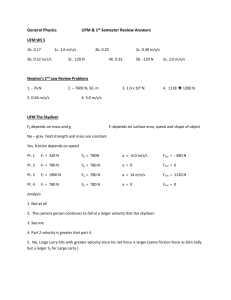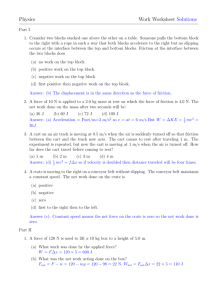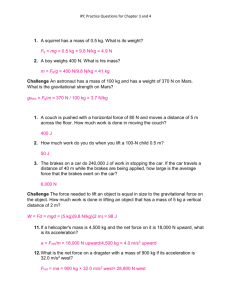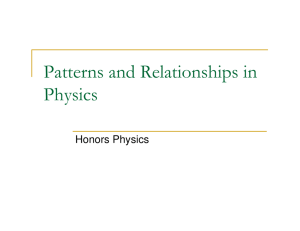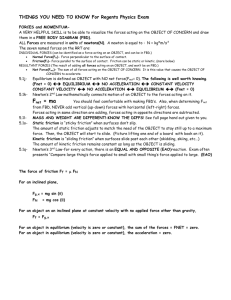Unit 2 Review, pages 208−215
advertisement
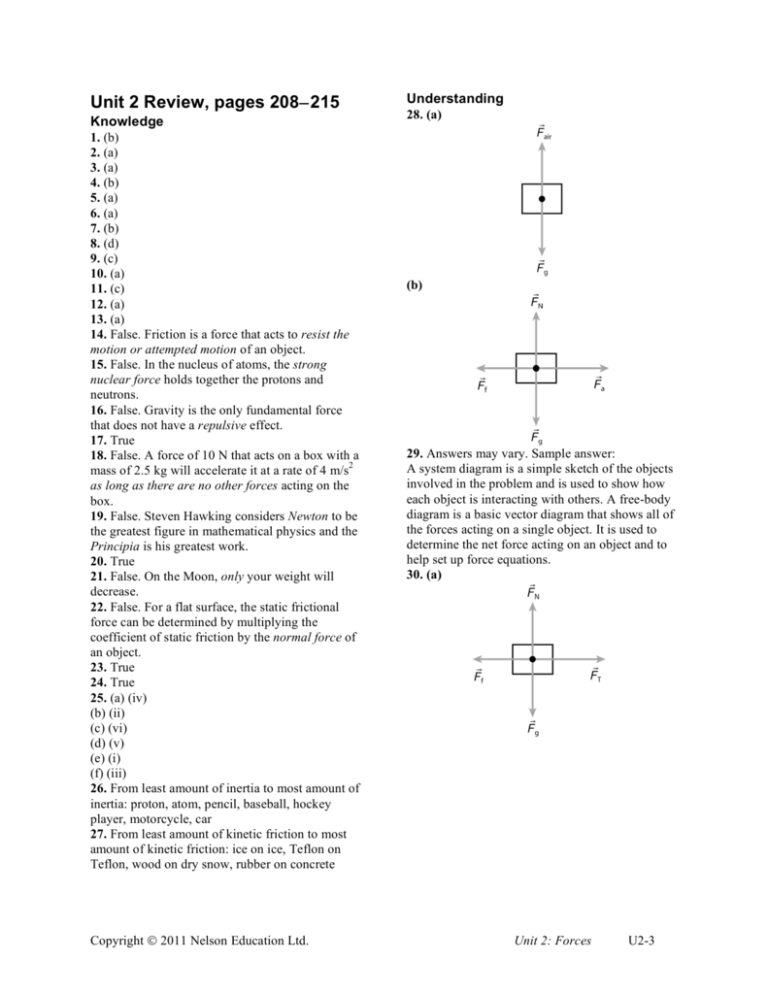
Unit 2 Review, pages 208−215 Knowledge 1. (b) 2. (a) 3. (a) 4. (b) 5. (a) 6. (a) 7. (b) 8. (d) 9. (c) 10. (a) 11. (c) 12. (a) 13. (a) 14. False. Friction is a force that acts to resist the motion or attempted motion of an object. 15. False. In the nucleus of atoms, the strong nuclear force holds together the protons and neutrons. 16. False. Gravity is the only fundamental force that does not have a repulsive effect. 17. True 18. False. A force of 10 N that acts on a box with a 2 mass of 2.5 kg will accelerate it at a rate of 4 m/s as long as there are no other forces acting on the box. 19. False. Steven Hawking considers Newton to be the greatest figure in mathematical physics and the Principia is his greatest work. 20. True 21. False. On the Moon, only your weight will decrease. 22. False. For a flat surface, the static frictional force can be determined by multiplying the coefficient of static friction by the normal force of an object. 23. True 24. True 25. (a) (iv) (b) (ii) (c) (vi) (d) (v) (e) (i) (f) (iii) 26. From least amount of inertia to most amount of inertia: proton, atom, pencil, baseball, hockey player, motorcycle, car 27. From least amount of kinetic friction to most amount of kinetic friction: ice on ice, Teflon on Teflon, wood on dry snow, rubber on concrete Copyright 2011 Nelson Education Ltd. Understanding 28. (a) (b) 29. Answers may vary. Sample answer: A system diagram is a simple sketch of the objects involved in the problem and is used to show how each object is interacting with others. A free-body diagram is a basic vector diagram that shows all of the forces acting on a single object. It is used to determine the net force acting on an object and to help set up force equations. 30. (a) Unit 2: Forces U2-3 (b) 35. (a) According to Newton’s second law, an object will accelerate in the direction of the net force with a magnitude given by a = (c) Answers may vary. Sample answer: There are no differences between the FBDs in parts (a) and (b). The direction of each arrow depends on the direction you choose to start drawing a FBD. If you choose right for the direction of the pulling force in (a) and you choose right for the direction of the pushing force in (b), you will end up with the same force diagram for the two different situations. 31. Choose force northward as positive. So force southward is negative. Fnet = +42 000 N + ( ! 1200 N) Fnet = +40 800 N The net horizontal force on the plane is 40 800 N [northward]. 32. According to Newton’s first law, when an object is at rest, the net force on the object must be zero. So the normal force pushing upward on the book must be equal to the force of gravity pulling downward for the book to remain at rest. 33. Answers may vary. Sample answer: The ball is in a horizontal motion when it is in the ballistic cart. Since there are no horizontal forces acting on the ball, it continues this horizontal motion following Newton’s first law. When the ball is fired upward, it rises and falls due to the shooting force and the force of gravity in the vertical direction, but at the same time continues to move horizontally. As a result, the ball follows an arched path. 34. Choose right as positive. So left is negative. Since the rope does not break and the students are stationary, Fnet = 0. ! ! ! ! ! Fnet = FR1 + FR2 + FL1 + FL2 0 = +95 N + 87 N + (!104 N) + FL2 FL2 = !78 N ! FL2 = 78 N [left] Fnet m . If two cars are pushed by an equivalent net force, the one that has less mass will accelerate faster. (b) As more boxes are added to the cart, the mass of the cart will increase. If the person continues to pull with a constant force, the acceleration of the cart will decrease. ! 36. (a) Given: m = 68 kg; a = 2.4 m/s2 [forwards] ! Required: Fnet Analysis: Use the equation Fnet = ma to calculate Fnet. Choose forwards as positive. So backwards is negative. Solution: Fnet = ma = (68 kg)(+2.4 m/s 2 ) Fnet = +160 N Statement: The net force acting on the sprinter is 160 N [forwards]. ! (b) Given: m = 0.425 kg; a = 9.8 m/s2 [down] ! Required: Fnet Analysis: Use the equation Fnet = ma to calculate Fnet. Choose up as positive. So down is negative. Solution: Fnet = ma = (0.425 kg)(-9.8 m/s 2 ) Fnet = !4.2 N Statement: The net force acting on the baseball is 4.2 N [down]. ! 37. (a) Given: m = 2200 kg; Fnet = 4500 N [N] ! Required: a Analysis: Use the equation a = Fnet m to calculate a. Choose north as positive. So south is negative. Solution: Fnet m +4500 N = 2200 kg a= a = +2.0 m/s 2 ! a = 2.0 m/s 2 [N] Statement: The acceleration of the car is 2 2.0 m/s [N]. The fourth student on the left is pulling with a force of 78 N [left]. Copyright 2011 Nelson Education Ltd. Unit 2: Forces U2-4 (b) Given: m = 71.2 kg; Fnet = 245 N [up] Required: a Analysis: Use the equation a = Fnet m to calculate a. Choose up as positive. So down is negative. Solution: Fnet m +245 N = 71.2 kg a= a = +3.44 m/s 2 ! a = 3.44 m/s 2 [up] Fnet = Fg ! FT m2 a = m2 g ! FT (Equation 2) Add the equations to solve for a. m1a + m2 a = FT + m2 g ! FT (m1 + m2 )a = m2 g m2 g a= m1 + m2 = Statement: The acceleration of the skydiver is 2 3.44 m/s [up]. 38. Given: m = 0.175 kg; a = 1.3 m/s2 ! Required: Fnet Analysis: The frictional force is the net force acting on the puck. Use the equation Fnet = ma to calculate Fnet. Choose forwards as positive. So backwards is negative. Since the puck is slowing down, the acceleration should be negative (backwards). Solution: Fnet = ma = (0.175 kg)( ! 1.3 m/s 2 ) Fnet = !0.23 N ! Required: a Fnet m to calculate a. Choose north as positive. So south is negative. Solution: Fnet m !8.0 " 10 3 N = 0.145 kg a= a = !5.5 " 10 4 m/s 2 ! a = 5.5 " 10 4 m/s 2 [S] Statement: The acceleration of the ball is 4 2 5.5 × 10 m/s [S]. 40. Choose right as positive. So left is negative. (a) For the cart, Fnet = FT m1a = FT (Equation 1) Copyright 2011 Nelson Education Ltd. (0.20 kg)(+9.8 m/s 2 ) 0.4 kg + 0.20 kg a = +3.3 m/s 2 The acceleration of the cart is 3.3 m/s2 [right]. (b) For the cart, Fnet = FT ! Ff m1a = FT ! Ff (equation 1) For the hanging object, Fnet = Fg ! FT m2 a = m2 g ! FT (equation 2) Add the equations to solve for a. m1a + m2 a = FT ! Ff + m2 g ! FT (m1 + m2 )a = m2 g ! Ff a= = Statement: The frictional force acting on the puck is 0.23 N [backwards]. ! 39. Given: m = 0.145 kg; Fnet = 8.0 × 103 N [S] Analysis: Use the equation a = For the hanging object, m2 g ! Ff m1 + m2 (0.20 kg)(+9.8 m/s 2 ) ! 0.10 N 0.4 kg + 0.20 kg a = 3.1 m/s 2 The acceleration of the cart is 3.1 m/s2 [right]. (c) Use equation 2 in part (b). m2 a = m2 g ! FT FT = m2 g ! m2 a = m2 (g ! a) = (0.20 kg)(9.8 m/s 2 ! 3.1 m/s 2 ) FT = 1.3 N The magnitude of the tension in the string is 1.3 N. 41. (a) The force of the student pushing on the skateboard causes it to accelerate in that direction. According to Newton’s third law, the skateboard exerts a reaction force of equal magnitude pushing back on the student, causing him to accelerate away from the skateboard. (b) When the person leans against the wall with a certain amount of force, the wall exerts a reaction force of equal magnitude but in opposite direction on the person. The net force acting on the person is zero and the wall is anchored to the ground so they both remain stationary. Unit 2: Forces U2-5 (c) As the ball rolls forwards and hits the group of balls with a force, the group of balls exerts a reaction force of equal magnitude but in opposite direction on the ball, causing it to roll backwards. 42. (a) Given: m = 80 kg; Fa = 68 N; Ff = 30 N Required: a! Analysis: Choose forwards as positive. So backwards is negative. Use the equation Fnet = Fa + Ff to find a. Solution: Fnet = Fa + Ff ma = Fa + Ff (80 kg)a = 68 N + (!30 N) 38 N a= 80 kg a = 0.48 m/s 2 ! a = 0.48 m/s 2 [forward] Statement: The acceleration of the player is 2 0.48 m/s [forwards], off the boards. (b) The boards do not move because they are massive and anchored to the ground. Since a= Fnet m , for a large value of m, the value a will be very small. The force that the player pushes with is so small compared to the mass of the boards that their acceleration is not noticeable. 43. (a) Given: Fnet = 0 N; m = 0.50 kg, 2 g = –9.8 m/s Required: FT Analysis: . The forces on the weight are the tension pulling it upward and the gravity pulling it downward. Add all the vertical forces: Fnet = FT + Fg . Choose up as positive. So down is negative. Since the helicopter is stationary, Fnet = 0. Solution: Fnet = FT + Fg 0 = FT + mg FT = !mg = !(0.50 kg)(!9.8 m/s 2 ) FT = +4.9 N Statement: The tension in the string is 4.9 N. 2 (b) Given: m = 0.50 kg; g = –9.8 m/s ; 2 a = +0.80 m/s Required: FT Analysis: In this situation, Fnet = ma . Choose up as positive. So down is negative. Copyright 2011 Nelson Education Ltd. Solution: Fnet = FT + Fg ma = FT + mg FT = ma ! mg = (0.50 kg)(+0.80 m/s 2 ) ! (0.50 kg)(!9.8 m/s 2 ) FT = +5.3 N Statement: The tension in the string is 5.3 N. 2 (c) Given: m = 0.50 kg; g = –9.8 m/s ; 2 a = –0.92 m/s Required: FT Analysis: In this situation, Fnet = ma . Choose up as positive. So down is negative. Solution: Fnet = FT + Fg ma = FT + mg FT = ma ! mg = (0.50 kg)(!0.92 m/s 2 ) ! (0.50 kg)(!9.8 m/s 2 ) FT = +4.4 N Statement: The tension in the string is 4.4 N. 44. (a) The force of gravity and air resistance are the forces acting on the brick as it falls. (b) In the instant the brick is initially dropped, the force of gravity acts more strongly. (c) As the brick reaches its terminal speed, the force of gravity and air resistance are equal in magnitude and acting in opposite directions. 2 (d) Given: m = 0.22 kg; g = –9.8 m/s Required: Fair Analysis: Since the net force on the brick is zero, at terminal speed, Fair = Fg. Solution: Fair = Fg = mg = (0.22 kg)(9.8 m/s 2 ) Fair = 2.2 N Statement: The force of air resistance is 2.2 N. 45. (a) Answers may vary. Sample answer: One way to measure gravitational field strength is to measure the weight of a known mass and divide the weight by the mass. A second way is to measure the acceleration of an object falling from a known height. Unit 2: Forces U2-6 (b) Use the equation Fg = mg to determine g. Fg = mg g= Fg m 24.475 N = 2.50 kg g = 9.79 N/kg The gravitational field strength acting on the object is 9.79 N/kg. (c) This altitude is probably above sea level because the gravitational field strength is lower than that at sea level. 46. (a) Mass is the quantity of matter in an object. Weight is a measure of the force of gravity acting on an object. (b) It is possible to change the mass of an object by adding or removing material from that object. (c) To change the weight of an object, but not the mass, move the object to a location with a different gravitational field strength. (d) The magnitudes of an object’s mass and weight will be equal when the gravitational field strength equals 1 N/kg. 47. (a) If both cylinders hit the ground at the same time, the cylinder with the greater mass has a larger cross-sectional area. (b) If they have the same cross-sectional area, the cylinder with the greater mass will hit the ground first. (c) If both cylinders were dropped in a vacuum, there is no air resistance and they would hit the ground at the same time. 48. Draw a FBD of the chandelier. 49. (a) The forces acting on the rock are the force of gravity, the normal force, the applied force, and static friction. (b) 2 (c) Given: m! = 210 kg; g = –9.8 m/s Required: FN Analysis: Consider the vertical forces acting on the rock. Choose up as positive. So down is negative. Solution: Since the net force on the rock is zero, FN + Fg = 0 FN = !Fg = !mg = !(210 kg)(!9.8 m/s 2 ) FN = +2100 N Statement: The normal force acting on the rock is 2100 N [up]. 50. (a) Given: m = 5.0 kg; FSmax = 29.89 N Required: µS Analysis: Use the equation µS = FSmax FN to find µS. Solution: µS = = FSmax FN FSmax mg 28.89 N (5.0 kg)(9.8 m/s 2 ) µS = 0.61 = The chandelier is at rest. So the net force on the chandelier is zero. Choose up as positive. So down is negative. FN + Fg + Fa = 0 FN + (3.2 kg)(!9.8 m/s 2 ) + 53 N = 0 FN = !22 N The normal force acting on the chandelier is 22 N [down]. Copyright 2011 Nelson Education Ltd. Statement: The coefficient of static friction is 0.61. (b) The two materials involved in this interaction are leather and oak. 51. (a) Given: FN = 52 N; µS = 0.1 Required: FSmax Analysis: The initial force required is the maximum static friction. Use the equation FSmax = µS FN to calculate FSmax . Unit 2: Forces U2-7 Solution: Analysis: At the time the runner starts from rest, Fnet = FSmax . Use the equations FSmax = µS FN = (0.1)(52 N) FSmax = 5.2 N Fnet = ma to find a. Choose forwards as positive. FSmax = µS FN Statement: The magnitude of the initial horizontal force required is 5.2 N. (b) Given: FN = 52 N; µK = 0.03 Required: FK Analysis: The force required is the kinetic friction. Use the equation FK = µ K FN to calculate FK. Solution: FK = µK FN = (0.03)(52 N) FK = 1.6 N Statement: The force required to maintain the hut sliding at a constant speed is 1.6 N. 52. (a) Given: m = 12 kg; FSmax = 47 N Required: µS Analysis: Use the equation µ S = FSmax FN to find µS. Solution: µS = = FSmax FN FSmax mg 47 N (12 kg)(9.8 m/s 2 ) µS = 0.40 = Statement: The coefficient of static friction is 0.40. (b) Given: m = 12 kg; Fa = 47 N; a = 1.1 m/s2 Required: µK Analysis: Use the equations Fnet = FK + Fa and FK = µK FN to find µK. Choose forwards as positive. So backwards is negative. Solution: Fnet = FK + Fa ma = ! µK FN + 47 N ma = ! µK mg + 47 N (12 kg)(1.1 m/s 2 ) = ! µK (12 kg)(9.8 m/s 2 ) + 47 N µK = 0.29 Statement: The coefficient of kinetic friction is 0.29. 53. Given: m = 72 kg; µS = 0.79 ! Required: a Copyright 2011 Nelson Education Ltd. So backwards is negative. Solution: FSmax = µS FN Fnet = µS mg ma = µS mg a = µS g = (0.79)(9.8 m/s 2 ) a = 7.7 m/s 2 ! a = 7.7 m/s 2 [forward] Statement: The maximum acceleration of the 2 runner is 7.7 m/s [forwards]. 54. Given: m = 6.2 kg; a = 0.50 m/s2; µK = 0.24 Required: Fa Analysis: Use the equations Fnet = FK + Fa and FK = µK FN to find Fa. Solution: Choose forwards as positive. So backwards is negative. Fnet = FK + Fa ma = ! µK FN + Fa Fa = ma + µK FN = ma + µK mg = m(a + µK g) = (6.2 kg)[0.50 m/s 2 + (0.24)(9.8 m/s 2 )] Fa = 18 N Statement: The magnitude of the force that the man pulls is 18 N. 55. Given: m = 22 kg; vi = 5.2 m/s; µK = 0.44 Required: Δd Analysis: First use the equations Fnet = FK and FK = µK FN to find the acceleration of the box. Then use the equation v f 2 = v i 2 + 2a!d to calculate the distance travelled. Since the box comes to rest, vf = 0 m/s. Solution: Fnet = FK ma = µK FN ma = µK mg a = µK g = (0.44)(9.8 m/s 2 )] a = 4.31 m/s 2 (one extra digit carried) Unit 2: Forces U2-8 Now calculate the distance travelled. Choose forwards as positive. So backwards is negative. vf 2 = vi 2 + 2a!d 0 = vi 2 + 2a!d vi 2 = "2a!d vi 2 "2a (+5.2 m/s)2 = "2("4.31 m/s 2 ) !d = 3.1 m !d = Statement: The box slides 3.1 m before it comes to rest. 56. Answers may vary. Sample answers: (a) One safety feature is the seat belt. A seat belt is designed to keep a person in an optimal crash position in a car seat to prevent the person from accelerating toward the dashboard or windshield during a car accident. Another safety feature is the crumple zone. The crumple zones of a car are designed to crush during an accident. The crushing action increases the time it takes to stop the car during a collision, reducing both the acceleration and the forces acting on the people inside the car. (b) During a crash test, an engineer uses a dummy to accurately simulate what will happen to a person during a car accident. The information gathered includes the accelerations of different parts of the body (like the head and torso) using accelerometers, how much the chest gets compressed during the crash using a motion sensor, and other forces acting on the body using load sensors all over the body. (c) In the photograph, the crumple zone in the front of the car is crushed while the car test dummy stays inside in the car seat uninjured. 57. Answers may vary. Sample answer: When a person sits, the hip has to support the upper body’s weight and the hip slides quite often on different seat surfaces. So the material used in hip replacement must be strong, flexible but sturdy, wear resistant, and durable for the artificial hip to look good in its shape, function properly, and last longer. 58. Answers may vary. Students’ answers should explain their findings about snow tires. Sample student answer: The tread pattern on snow tires is specifically designed to dig into the snow and create more friction. They are also made from a softer rubber that allows the tires to flex in the winter and grip the road. Snow tires cannot be left on all year because the soft rubber will wear a lot Copyright 2011 Nelson Education Ltd. more easily during the summer and ruin their traction for the winter. Analysis and Application 59. (a) The ball should go up to a height of 25 cm because of inertia. The amount of inertia the ball carries down the first ramp is the same as that it will carry up the second ramp. (b) After rolling back, the ball should once again roll up to a height of 25 cm. (c) This cannot happen in real world because of friction. It causes the ball to slow down and lose inertia. 60. Given: v2 = 32 m/s; Δt = 0.42 s; m = 0.22 kg Required: Fnet Analysis: First use the equation v 2 = v1 + a!t to calculate the acceleration. Then use Fnet = ma to calculate the average force on the potatoes. Solution: At the beginning, the velocity of the potatoes is 0 m/s. v2 = v1 + a!t v2 = a!t v a= 2 !t 32 m/s = 0.42 s a = 76.2 m/s 2 (one extra digit carried) Now calculate the average force. Fnet = ma = (0.22 kg)(76.2 m/s 2 ) Fnet = 17 N Statement: The average force the potato gun exerts on the potatoes is 17 N. 61. Given: m = 71 kg; v1 = 3.4 m/s; v2 = 6.7 m/s; Δt = 2.8 s Required: Fnet Analysis: First use the equation v 2 = v1 + a!t to calculate the acceleration. Then use Fnet = ma to calculate the net force on the runner. Solution: v2 = v1 + a!t v " v1 a= 2 !t 6.7 m/s " 3.4 m/s = 2.8 s a = 1.18 m/s 2 (one extra digit carried) Unit 2: Forces U2-9 Now calculate the average force. Fnet = ma = (71 kg)(1.18 m/s ) 2 Fnet = 84 N Statement: The net force the runner experiences is 84 N. 62. (a) Given: mT = 9.0 kg + 3.0 kg = 12.0 kg; Ff = 18 N + 6.0 N = 24 N; Fa = 30.0 N ! Required: a Analysis: We can treat the two weights as one single object. Use the equations Fnet = Fa + Ff and Fnet = ma to calculate the acceleration. Choose forwards as positive. So backwards is negative. Solution: Fnet = Fa + Ff ma = Fa + Ff (12.0 kg)a = 30.0 N + (!24 N) a = 0.50 m/s 2 ! a = 0.50 m/s 2 [forward] Statement: The acceleration of the weights during 2 the first 5.0 s is 0.50 m/s [forwards]. (b) If the applied force is removed, the only horizontal force acting on the weights is friction, which is in the opposite direction of their motion. So the weight will slow down and stop. (c) Answers may vary. Sample answer: The two weights will move the same distance because the only force acting on the weights after the initial push is the frictional force, which is proportional to the normal force. Ff = µ K FN ma = µ K mg a = µK g The acceleration depends only on the coefficient of friction and the force of gravity, which are the same for both weights. Thus, both weights slow down at the same rate and travel the same distance. 63. Calculate the net force on the students and use Fnet = ma to calculate the acceleration. Choose right as positive. So left is negative. Fnet = FR1 + FR2 + FL1 + FL2 = +55 N + 65 N + (!58 N) + (!70 N) Fnet = !8 N The total mass of the students is: mT = 60 kg + 62 kg + 59 kg + 64 kg = 245 kg Copyright 2011 Nelson Education Ltd. Now calculate the acceleration. Fnet = mT a !8 N = (245 kg)a !8 N a= 245 kg a = !0.03 m/s 2 The students accelerate to the left with a 2 magnitude of 0.03 m/s . 64. (a) Given: m = 220 kg; Δv = 5.0 km/h; Δt = 8.0 s Required: Fdog !v to calculate the !t acceleration. Then use Fnet = ma to find Fdog . Analysis: First use a = Solution: Convert the velocity to SI metric units. ! km $ ! 1 h $ ! 1 min $ ! 1000 m $ 5.0 km/h = # 5.0 h &% #" 60 min &% #" 60 s &% #" 1 km &% " = 1.389 m/s (two extra digits carried) Then calculate the acceleration. !v !t 1.389 m/s = 8.0 s a= a = 0.1736 m/s 2 (two extra digits carried) Calculate the average applied force. Fnet = ma = (220 kg)(0.1736 m/s 2 ) Fnet = 38.19 N (two extra digits carried) For each dog, 38.19 N 9 = 4.2 N Fdog = Fdog Statement: The average force applied by each dog is 4.2 N. (b) The frictional force equals the total force applied by the dogs. Given: Fdog = 51 N; Fnet = 38.19 N Required: Ff Analysis: Fnet = Fa ! Ff Solution: Fa = 9 ! 51 N Fa = 459 N Unit 2: Forces U2-10 During the pulling motion, Solution: For the jumpers: 38.19 N = 459 N ! Ff Fnet = m j a j Fnet = Fa ! Ff Ff = 420 N Statement: The frictional force acting on the sled is 420 N in a direction opposite to the motion. 2 65. (a) Calculate 38% of 9.8 m/s . gMars = 0.38g = 0.38(9.8 m/s ) 2 gMars = 3.72 m/s 2 (one extra digit carried) The acceleration due to gravity on Mars is 2 3.7 m/s . 2 (b) Given: m = 180 kg; gMars = 3.72 m/s Required: FgMars Analysis: Use FgMars = mg Mars to calculate FgMars. Solution: FgMars = mgMars FgMars = (180 kg)(3.72 m/s 2 ) = 670 N Statement: The rover would weigh 670 N on Mars. (c) Given: gMars = 0.38g; Fg = 8500 N Required: FgMars Analysis: Use FgMars = mg Mars to calculate FgMars. Solution: FgMars = mgMars = m(0.38g) = 0.38mg = 0.38Fg FgMars = 0.38(8500 N) = 3200 N Statement: The rock would experience a force of 3200 N on Mars. 66. (a) As the jumpers jumps off the boat, they exert an action force pushing the boat to the left. The boat exerts a reaction force of the same magnitude but to the opposite direction (to the right) on the jumpers. (b) Given: Fnet = 280 N; mj = 130 kg; mb = 220 kg ! ! Required: a j ; ab aj = = Fnet mj +280 N 130 kg a j = +2.2 m/s 2 ! a j = +2.2 m/s 2 [right] For the boat, the net force is acting in the opposite direction. Fnet = mb ab F ab = net mb !280 N = 220 kg ab = !1.3 m/s 2 ! ab = !1.3 m/s 2 [left] Statement: The acceleration of the jumpers is 2 2.2 m/s [right] and the acceleration of the boat is 2 1.3 m/s [left]. 67. Answers may vary. Sample answer: As the heated and compressed air is expelled rapidly out of the rear of the engine, according to Newton’s third law, the heated and expanded air exerts an equal but opposite force forwards to the back of the engine, causing the jet to accelerate. 68. (a) Given: m1 = 2.0 kg; m2 = 4.0 kg; mT = 2.0 kg + 4.0 kg = 6.0 kg; FTA = 12 N [forwards] ! ! Required: a ; FTB Analysis: Since there are no other forces acting on the masses, we can treat the two masses as a single object and use the equations FTA = Fnet and Fnet = m T a to calculate a. Then consider the forces on mass m2. Use FTB = m 2 a to calculate FTB. Choose forwards as positive. So backwards is negative. Analysis: Use Fnet = ma to calculate the accelerations of the jumpers and the boat. Choose right as positive. So left is negative. Copyright 2011 Nelson Education Ltd. Unit 2: Forces U2-11 Solution: Fnet = mT a FTA = mT a F a = TA mT +12 N = 6.0 kg a = +2.0 m/s 2 ! a = 2.0 m/s 2 [forward] For mass m2, the net force acting is FTB. FTB = m2 a = (4.0 kg)(2.0 m/s 2 ) FTB = 8.0 N 2 Statement: The acceleration is 2.0 m/s [forwards] and the tension in string B is 8.0 N. (b) Given: m1 = 2.0 kg; m2 = 4.0 kg; mT = 2.0 kg + 4.0 kg = 6.0 kg; FTA = 12 N [forwards]; µK = 0.10 ! ! Required: a ; FTB Analysis: We can treat the two masses as a single object and use the equations Fnet = FTA + Ff and Fnet = m T a to calculate a. Then consider the forces on mass m2. Use Fnet = FTB + Ff to calculate FTB. Choose forwards as positive. So backwards is negative. Solution: Fnet = FTA + Ff mT a = FTA ! µK FN mT a = FTA ! µK mT g (6.0 kg)a = +12 N ! (0.10)(6.0 kg)(9.8 m/s 2 ) a = +1.0 m/s 2 ! a = 1.0 m/s 2 [forward] For mass m2, the forces acting are FTB and Ff. Fnet = FTB + Ff m2 a = FTB ! µK FN FTB = m2 a + µK FN = m2 a + µ K m2 g = m2 (a + µK g) = (4.0 kg)[(1.0 m/s 2 + (0.10)(9.8 m/s 2 )] FTB = 8.0 N Statement: The acceleration is 1.0 m/s2 [forwards] and the tension in string B is 8.0 N. Copyright 2011 Nelson Education Ltd. (c) The acceleration of the masses in part (a) could be reduced to half in the presence of friction as the frictional force acting in the opposite direction is almost half the applied force. The tension in string B is not reduced very much since it is the result of both the net force and the frictional force. The smaller the frictional force, the greater is the acceleration (greater net force) so the magnitude of string B has not changed that much. 69. (a) Given: m1 = 4.3 kg; m2 = 5.5 kg; m!T = 4.3 kg + 5.5 kg = 9.8 kg; Fpull = 25 N [forwards] ! Required: a Analysis: Since there are no other forces acting on the wagons, we can treat the two wagons as a single object and use the equations Fpull = Fnet and Fnet = m T a to calculate a. Choose forwards as positive. So backwards is negative. Solution: Fnet = mT a Fpull = mT a a= Fpull mT +25 N = 9.8 kg a = +2.6 m/s 2 ! a = 2.6 m/s 2 [forward] Statement: The acceleration of both of the wagons 2 is 2.6 m/s [forwards]. (b) Given: m1 = 4.3 kg; m2 = 5.5 kg; ! Fpull = 25 N [forwards] Required: FTA; FTB Analysis: The net force on wagon 1 is the tension in rope A. Use FTA = m1 a to calculate FTA. Solution: FTA = m1a FTA = (4.3 kg)(2.55 m/s 2 ) = 11 N The tension in rope B equals the magnitude of the pulling force. So, FTB = 25 N. Statement: The tension in rope A is 11 N and the tension in rope B is 25 N. 70. (a) Given: m1 = 25 kg; m2 = 45 kg; mT = 25 kg +! 45 kg = 70 kg ! F F Required: N1 ; N2 Analysis: Since no other forces are acting, use FN = mg to calculate FN. Unit 2: Forces U2-12 Solution: For box 1, the normal force is from box 2. FN1 = m1 g Solution: ! For box 1, Fa = 0. FN1 + m1 g = 0 = (25 kg)(9.8 m/s 2 ) FN1 + (25 kg)( ! 9.8 m/s 2 ) = 0 FN1 = 250 N FN1 = +250 N ! FN1 = 250 N [up] For box 2, the normal force is from the floor. FN2 = mT g ! For box 2, Fa = 55 N [up]. = (70 kg)(9.8 m/s 2 ) FN2 = 690 N Statement: The normal force on box 1 is 250 N [up] and on box 2 is 690 N [up]. (b) Given: m1 = 25 kg; m2 = 45 kg; ! F mT = 25 kg + 45 kg = 70 kg; P1 = 55 N [up] ! ! Required: FN1 ; FN2 Analysis: Consider the vertical forces acting. Since each box is not moving, the total of the forces in the vertical direction is zero. Use FN + Fg + Fa = 0 to calculate FN. Choose up as positive. So down is negative. Solution: ! For box 1, Fa = 55 N [up]. FN1 + m1 g + FP1 = 0 FN1 + (25 kg)( ! 9.8 m/s 2 ) + 55 N = 0 FN1 = +190 N ! FN1 = 190 N [up] ! For box 2, Fa = 55 N [up]. FN2 + mT g + FP1 = 0 FN2 + (70 kg)( ! 9.8 m/s 2 ) + 55 N = 0 FN2 = +630 N ! FN2 = 630 N [up] Statement: The normal force on box 1 is 190 N [up] and on box 2 is 630 N [up]. (c) Given: m1 = 25 kg; m2 = 45 kg; ! mT = 25 kg + 45 kg = 70 kg; FP2 = 55 N [up] ! ! Required: FN1 ; FN2 Analysis: Consider the vertical forces acting. Since each box is not moving, the total of the forces in the vertical direction is zero. Use FN + Fg + Fa = 0 to calculate FN. Choose up as positive. So down is negative. Copyright 2011 Nelson Education Ltd. FN2 + mT g + FP2 = 0 FN2 + (70 kg)( ! 9.8 m/s 2 ) + 55 N = 0 FN2 = +630 N ! FN2 = 630 N [up] Statement: The normal force on box 1 is 250 N [up] and on box 2 is 630 N [up]. (d) Answers may vary. Sample answer: The answers to (b) and (c) indicates that the change to the upward pull on the boxes affects the normal force of box 1 because the normal force on box 1 depends on the applied pulling force on it and is independent of the mass of box 2. The normal force on box 2 depends on the total mass of the two boxes and the total pulling force on either box. Since the total of these two are the same in (b) and (c), the normal force on box 2 is the same. 71. Given: m1 = 15 kg; m2 = 25 kg; µS = 0.45 Required: a Analysis: The small block can accelerate at a maximum rate with the large block when the net force acting on it is equal to the maximum static friction between the blocks. Use the equations FS = µ s FN and Fnet = ma to find a. Solution: Fnet = FS ma = µS FN ma = µS mg µ mg a= S m = µS g = (0.45)(9.8 m/s 2 ) a = 4.4 m/s 2 Statement: The maximum acceleration the blocks 2 can have is 4.4 m/s . 72. (a) Given: Fa = 250 N [forwards]; µK = 0.4; 2 a = 0.88 m/s . Required: m Unit 2: Forces U2-13 Analysis: Use the equations Fnet = Fa + Ff and Fnet = ma to calculate m. Choose forwards as positive. So backwards is negative. Solution: Fnet = Fa + Ff ma = Fa ! µK FN ma = Fa ! µK mg ma + µK mg = Fa m(a + µK g) = Fa m= Fnet = F1 ! Ff m1a1 = F1 ! µK FN m1a1 = F1 ! µK m1 g F ! µK m1 g a1 = 1 m1 = 420 N ! (0.30)(120 kg)(9.8 m/s 2 ) 120 kg a1 = 0.56 m/s 2 Fa a + µK g 250 N 0.88 m/s + (0.4)(9.8 m/s 2 ) = 52 kg m = 50 kg = Solution: For team 1, 2 Statement: The mass of the block is 50 kg. ! (b) Given: Fa = 250 N; m = 52 kg (one extra digit carried) Required: µK Analysis: Since the block is moving at a constant speed, Fnet = 0. The magnitude of the applied force equals that of the kinetic friction. Solution: Fa = FK Fa = µK FN Fa = µK mg F µK = a mg 250 N = (52 kg)(9.8 m/s 2 ) µK = 0.49 Statement: The coefficient of kinetic friction between the block and the new surface is 0.49. 73. Given: m1 = 120 kg; F1 = 420 N; m2 = 130 kg; F2 = 460 N; µK = 0.30 Required: a1; a2 Analysis: Use the equations Ff = µK FN and Fnet = ma to determine the acceleration of each team. For team 2, Fnet = F2 ! Ff m2 a2 = F2 ! µK FN m2 a2 = F2 ! µK m2 g F ! µ K m2 g a2 = 2 m2 = 460 N ! (0.30)(130 kg)(9.8 m/s 2 ) 130 kg a2 = 0.60 m/s 2 2 Statement: The acceleration of team 1 is 0.56 m/s 2 and that of team 2 is 0.60 m/s . So team 2 is faster. 74. (a) Given: m = 72 kg; µS = 0.80 Required: a Analysis: When walking without slipping, the maximum net force on the person equals the maximum static friction. Use Fnet = FS = µS FN to max calculate the maximum acceleration. Solution: Fnet = FSmax ma = µS FN a = µS g = (0.80)(9.8 m/s 2 ) a = 7.8 m/s 2 Statement: The acceleration of the person walking 2 on concrete without slipping is 7.8 m/s . (b) Given: m = 72 kg; µS = 0.075 Required: a Analysis: As in part (a), use Fnet = FSmax = µS FN to calculate the maximum acceleration. Solution: Fnet = FSmax ma = µS FN a = µS g = (0.075)(9.8 m/s 2 ) a = 0.74 m/s 2 Copyright 2011 Nelson Education Ltd. Unit 2: Forces U2-14 Statement: The acceleration of the person walking 2 on ice without slipping is 0.74 m/s . 75. (a) Both blocks have the same normal force acting on them. (b) For a square centimetre of surface in contact, the block with less surface area would have a stronger normal force since it has the same total force shared by less area. (c) If you know the frictional force per area, multiply it by the total area to get the total frictional force. (d) Answers may vary. Sample answer: For the same frictional force, the force per area is small for an object with a large surface area in contact, but this large area has a small force acting on it. Conversely, for the same frictional force, an object with a small surface area in contact has a large force per area, but this force is acting on a small area. The total frictional force acting on the object in either case is the same. As a result, the frictional force acting on an object is independent of the surface area in contact. 76. Answers may vary. Sample answer: Tread pattern could play a role in preventing hydroplaning. An example could be a tread pattern that sheds water away from the tire instead of requiring it to channel through the entire tread pattern. 77. Answers may vary. Students’ answers should discuss a safety feature on a car and explain why they think it is the most important. Sample answer: In my opinion, the most important safety device on a car is the seat belt. This works by using a pendulum so that when the car stops suddenly, the inertia from the pendulum causes it to swing and lock a gear in place. This holds the seat belt in place and keeps the passenger from flying out of the car. This is a relatively old device compared to the other safety features mentioned in the unit. There are not many ways for this to improve other than using different harness systems to distribute pressure from the belt across a larger area of the passenger. Evaluation 78. Answers may vary. Sample answers: (a) The government should pass the legislation because the use of a hand-held cellphone could cause distractions that increases the risk of losing control of the vehicle, a large number of car accidents have proved to be related to the use of cell-phones while driving, and the driver should pay full attention to operating the vehicle with his Copyright 2011 Nelson Education Ltd. hands on the steering wheel instead of doing something else. (b) This legislation would discourage the use of hand-held cellphones during driving and thus reduce the risks of distracted driving, which may cause serious car accidents and body injuries. (c) I think this legislation is necessary as studies have shown that driving while talking on a cell phone also reduces a driver’s response time to road conditions, another cause of major car accidents. Therefore, this legislation is very necessary. 79. Answers may vary. Sample answers: (a) My favourite sport is soccer where the main action would be kicking and dribbling the ball. When kicking the ball, friction acts between the shoe and the ball. In this case more friction is desired. Increasing the friction between the shoe and the ball gives more control over the kick and prevents the ball from slipping out of control. (b) The greatest force of friction comes from the ground and soccer cleats. This large amount of friction is highly desirable so that you do not slip and fall when running or kicking. The least amount of friction occurs between the ball and the grass. Here a moderate amount of friction is desired. With too much friction, the ball will slow down too fast, but with too little friction, the ball will get away from you, which makes it hard to control. (c) Soccer cleats are used to create more friction. They have spikes on the bottom that dig into the ground to prevent you from slipping. The goalies also wear gloves that have a rubber coating on them. This helps them catch the ball when they are trying to make a save. 80. Answers may vary. Sample answers: (a) In the human body, perhaps the most important type of bearing is our joints. Many of our joints such as the shoulders and hips are ball-in-socket type of joints, which compare to a ball bearing. Joints also use a fluid to help lubricate and reduce the friction between them, which could be compared to a type of fluid bearing. Our body also uses fluids such as cholesterol to help blood flow smoothly in the veins. (b) Inside our bodies, there is not really anything that increases the amount of friction. However, on the outside of our bodies, our hands and feet are designed to increase the friction between contact surfaces. This helps grip things that are being picked up and helps prevent the feet from slipping. Fingerprints and footprints act much like the tread design on tires. Another body part that increases friction is the hair on our body. This is probably Unit 2: Forces U2-15 not designed to specifically increase friction but rather help provide insulation for the body. The hairs on nose and eyes slow down the air and help protect the nose and eyes from dust particles. 81. Answers may vary. (a) Students’ answers should include the knowledge gained from their research in Section 4.6 that helps them determine whether or not the costs of having snow tires are worth the safety the snow tires provide. (b) Students’ answers should include their thoughts about how the government could get involved and provide incentives for people to buy snow tires. They should discuss how this might save money, reducing the costs of emergency services for example, and how much this would cost. They should use this information to determine the action for the government. 83. Answers may vary. (a) Students’ answers should reflect on the material they have learned and describe any sudden moments of insight they might have had when things started to make sense. (b) Students’ answers should discuss whether or not their understanding of the laws of kinematics has changed the way they view common occurrences and whether or not they think about the forces causing or reacting from them. 84. Answers may vary. Students’ answers should discuss their understanding of friction and how their understanding has changed. 85. Answers may vary. Students’ answers should explain that the safety features in a car do not make cars completely safe or accident resistant due to the different forces acting in different ways on the passengers. Reflect on Your Learning 82. Answers may vary. Sample answer: System diagrams give you a picture of the situation you are working with, but do not show any of the forces. They do however, give you a better idea of how the objects are interacting, which can help you draw a free-body diagram. Free-body diagrams show all of the forces acting on an object, but do not give you an idea of the situation. Free-body diagrams tend to be more useful though, since knowing the magnitude and directions of forces is what enables you to set up equations to solve the problem. It is possible to solve a problem if you are given a free-body diagram and the force values, but you cannot solve a problem with a system diagram alone. You would need to draw an FBD from the system diagram to solve the problem. Research 86. Answers may vary. Students’ answers should discuss the causes of friction and may choose to describe how no surface is perfectly smooth, and how the molecules on a microscopic level run into each other and slow the motion down when surfaces are in contact with each other. 87. Answers may vary. Students’ answers should discuss the topic of superfluids and how they act as if there is no friction. Superfluids are only possible at close to absolute zero temperatures and have the strange phenomena of being able to climb the walls of a container. 88. Answers may vary. Students’ answers should discuss the speed-distance detection systems on cars and whether or not they are successful in preventing collisions. 89. Answers may vary. Students’ answers should give a description of how a side curtain airbag works, when it is deployed, how it is different from a side airbag, and the safety standards that it is able to meet. Copyright 2011 Nelson Education Ltd. Unit 2: Forces U2-16


